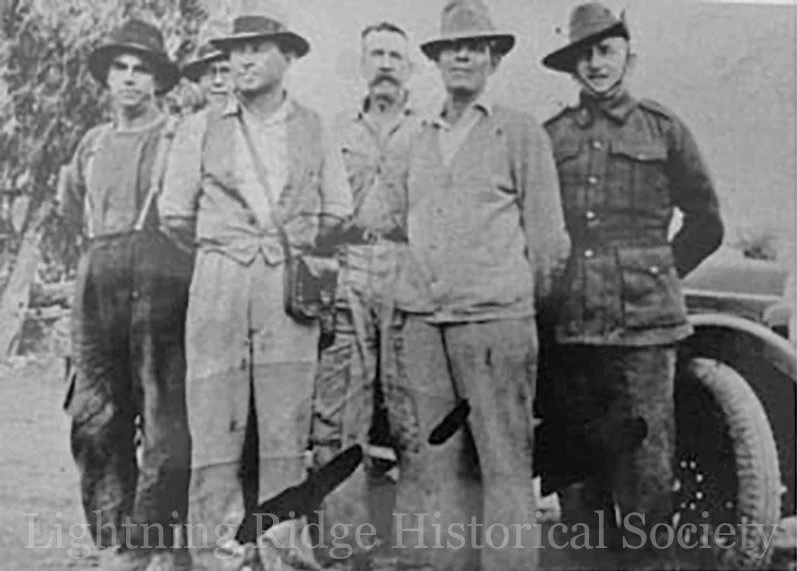Harold Frazer
Left-to-right: George “Little Yorky” Stacey WW1, Unknown, Robert “Bob” Henry Bruce, Peter Campbell McColl, Harold William Francis Frazer WW1 & Frank “Scotty” Grant WW2. Photo taken 1940.
Harold William Francis Frazer (sometimes spelled Fraser) was born in 1882 at Goodooga, son of Charles Frazer and Maria Flood.
He served in World War I, enlisting in the army at Goodooga joining the famous March of the Wallabies at Walgett in 1915. He served in the 34th Infantry Battalion. Frazer received mild gas poisoning during the war. He was discharged from service 31 January 1920.
While in hospital in London, he met and married his wife Dorothy Elizabeth “Dolly” Wilson. Dolly would go on to become a talented opal cutter at Lightning Ridge.
“Harold Fraser, a returned soldier, carried a 60lb swag from Walgett to the Ridge, forty miles, and a week later his wife, an English girl, arrived on the field. She chanced to kick a piece of dump-clay, and discovered that it contained opal. Her husband immediately commenced noodling there, and in five weeks cleared £117, which was better than carrying a swag through the heat. He is now the chief opal cutter on the field, with a compact little plant housed in a picturesque shed, where precious opals casually play kiss-in-the-ring with emery wheels, and look much better for it. He certainly does not agree that opals are, unlucky, and he is handling them daily.”
Frazer was one of the founding members of the Lightning Ridge branch of the Returned Servicemen’s League (RSL), along with his brother-in-law Joe Willis and Walter Hague.
“A champion opal cutter, who faced the “Pandora” stone. A cracker-jack on making tinsel doublets. (They were black potch bottom, tinsel in between, amber coloured potch on top.)”
Harold Frazer passed away on 28 December 1961 in Sydney, and some of his ashes were scattered at the Lightning Ridge Cemetery.
Signature of Harold Frazer, sourced from the 1929 petition for a public park at Lightning Ridge.
Article: Research by Leisa Carney, edited by Russell Gawthorpe. LRHS research compiled by Len Cram and Barbara Moritz. Sources: ‘Romance Surrounds Death of Famous German Flying Ace - Are Opals Unlucky? - Home of the World-renowned Black Opal as it Really is - Town of the Tree of Knowledge’, Smith’s Weekly, 1 September, 1934, p. 4; ‘Flashing Beauty of Opals - Play of Prisms - Due to Cracks - Life-Story of Gem’, The Sun, 18 June 1935, p. 7; ‘The Only One of her Kind - She Cuts Opals - Yorkshire Lass - Task that Thrills’, Daily Standard, 18 June 1935, p. 4; The Lightning Ridge Book, Stuart Lloyd, 1967, pp. 28-29, 41, 111.


